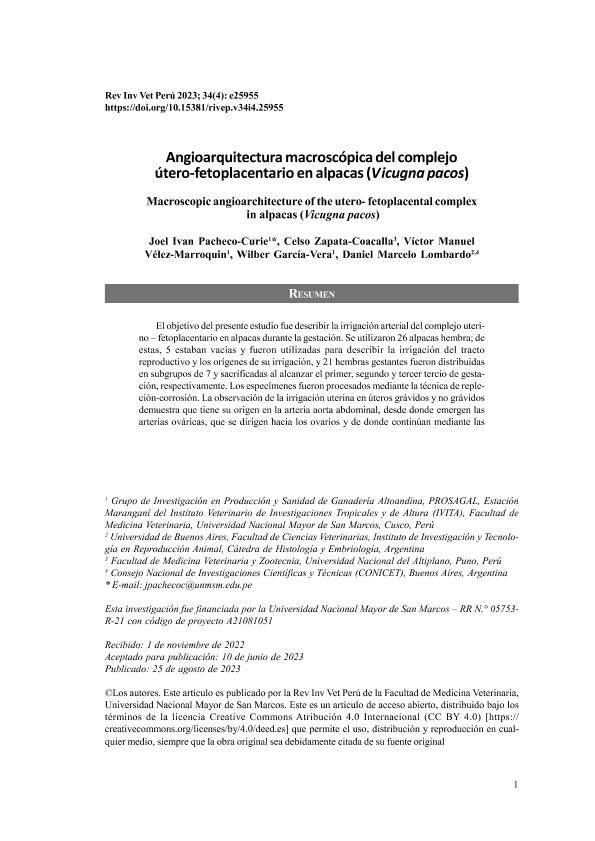Mostrar el registro sencillo del ítem
dc.contributor.author
Pacheco Curie, Joel Ivan
dc.contributor.author
Zapata Coacalla, Celso
dc.contributor.author
Vélez Marroquin, Víctor Manuel
dc.contributor.author
García Vera, Wilber
dc.contributor.author
Lombardo, Daniel Marcelo

dc.date.available
2024-01-22T11:38:59Z
dc.date.issued
2023-08
dc.identifier.citation
Pacheco Curie, Joel Ivan; Zapata Coacalla, Celso; Vélez Marroquin, Víctor Manuel; García Vera, Wilber; Lombardo, Daniel Marcelo; Angioarquitectura macroscópica del complejo útero-fetoplacentario en alpacas (Vicugna pacos); Universidad Nacional Mayor de San Marcos. Facultad de Medicina Veterinaria; Revista de Investigaciones Veterinarias del Perú; 34; 4; 8-2023; 1-12
dc.identifier.issn
1682-3419
dc.identifier.uri
http://hdl.handle.net/11336/224380
dc.description.abstract
El objetivo del presente estudio fue describir la irrigación arterial del complejo uterino – fetoplacentario en alpacas durante la gestación. Se utilizaron 26 alpacas hembra; de estas, 5 estaban vacías y fueron utilizadas para describir la irrigación del tracto reproductivo y los orígenes de su irrigación, y 21 hembras gestantes fueron distribuidas en subgrupos de 7 y sacrificadas al alcanzar el primer, segundo y tercer tercio de gestación, respectivamente. Los especímenes fueron procesados mediante la técnica de repleción-corrosión. La observación de la irrigación uterina en úteros grávidos y no grávidos demuestra que tiene su origen en la arteria aorta abdominal, desde donde emergen las arterias ováricas, que se dirigen hacia los ovarios y de donde continúan mediante las arterias uterinas craneales e ingresan hacia los cuernos uterinos para anastomosarse con las ramas lateral y ventral de las arterias uterinas caudales que tienen su origen en las arterias iliacas. De las ramas laterales de las arterias uterinas, emergen las arterias espiraladas que irrigan los cuernos uterinos, las mismas que se encuentran en mayor cantidad en el cuerno izquierdo y que en hembras preñadas se observan estiradas. La rama medial de la arteria uterina caudal derecha se dirige hacia el cuerno izquierdo, incrementando así la irrigación sanguínea en ese cuerno. En la placenta, se forman muchos vasos pequeños que se juntan para ingresar hacia el feto mediante las venas umbilicales, las que se anastomosan formando el seno venoso, que vierte la sangre hacia los capilares sinusoides hepáticos en una gran ramificación, que luego se vierte en tres vasos medianos que al juntarse, emergen por la parte posterior del hígado y se une hacia la vena cava posterior, mediante el llamado conducto venoso, esta vierte la sangre en la aurícula derecha, desde donde la sangre se dirige a la aurícula izquierda mediante el agujero oval, luego hacia el ventrículo izquierdo desde donde emerge la arteria aorta, donde se encuentra el conducto arterioso que desvía parte de esta sangre hacia el tronco pulmonar. La arteria aorta continua su recorrido hacia caudal y luego de la bifurcación de las arterias iliacas, emergen las dos arterias umbilicales que se dirigen hacia la placenta. Se propone identificarlas con el nombre de arterias placentarias izquierda y derecha, así como sus venas satélites.
dc.description.abstract
The aim of this study was to describe the arterial supply of the uterine-fetoplacental complex in alpacas during gestation. In total, 26 female alpacas were used; of these, 5 non-pregnant females were used to describe the irrigation of the reproductive tract and the origins of its irrigation; and 21 pregnant females were distributed in subgroups of 7 and slaughtered when they reached the 1st, 2nd and 3rd third of gestation, respectively. The specimens were processed using the filling-corrosion technique. Observation of uterine irrigation in pregnant and non-gravid uteri shows that it originates from the abdominal aorta artery, from where the ovarian arteries emerge, which pass towards the ovaries and from where they continue through the cranial uterine arteries and enter the uterine horns where they anastomose with the lateral and ventral branches of the caudal uterine arteries that take their origin from the iliac arteries. From the lateral branches of the uterine arteries, the spiral arteries that irrigate the uterine horns emerge, the same ones that are found in greater numbers in the left horn and that in pregnant females are observed stretched. The medial branch of the right caudal uterine artery passes into the left horn, thereby increasing the blood supply to that horn. In the placenta, many small vessels form that come together to enter the fetus through the umbilical veins, which anastomose to form the sinus venosus, which pours blood into the hepatic sinusoidal capillaries in a large branch, which then pours into three medium vessels that when joined, emerge from the posterior part of the liver and join to the posterior vena cava, through the so-called ductus venosus, this pours the blood into the right atrium, from where the blood goes to the left atrium through the foramen ovale, then towards the left ventricle from where the aorta artery emerges, where the ductus arteriosus is found which diverts part of this blood towards the pulmonary trunk. The aortic artery continues its course caudally and after the bifurcation of the iliac arteries, the two umbilical arteries emerge that go towards the placenta. It is proposed to identify them with the name of left and right placental arteries, as well as their satellite veins.
dc.format
application/pdf
dc.language.iso
spa
dc.publisher
Universidad Nacional Mayor de San Marcos. Facultad de Medicina Veterinaria
dc.rights
info:eu-repo/semantics/openAccess
dc.rights.uri
https://creativecommons.org/licenses/by/2.5/ar/
dc.subject
ALPACA
dc.subject
FETAL IRRIGATION
dc.subject
FETUS
dc.subject
PLACENTA
dc.subject
UTERUS
dc.subject.classification
Otras Ciencias Veterinarias

dc.subject.classification
Ciencias Veterinarias

dc.subject.classification
CIENCIAS AGRÍCOLAS

dc.title
Angioarquitectura macroscópica del complejo útero-fetoplacentario en alpacas (Vicugna pacos)
dc.title
Macroscopic angioarchitecture of the utero- fetoplacental complex in alpacas (Vicugna pacos)
dc.type
info:eu-repo/semantics/article
dc.type
info:ar-repo/semantics/artículo
dc.type
info:eu-repo/semantics/publishedVersion
dc.date.updated
2024-01-18T14:11:52Z
dc.identifier.eissn
1609-9117
dc.journal.volume
34
dc.journal.number
4
dc.journal.pagination
1-12
dc.journal.pais
Perú

dc.journal.ciudad
Lima
dc.description.fil
Fil: Pacheco Curie, Joel Ivan. Universidad Nacional Mayor de San Marcos; Perú
dc.description.fil
Fil: Zapata Coacalla, Celso. Universidad Nacional del Altiplano; Perú
dc.description.fil
Fil: Vélez Marroquin, Víctor Manuel. Universidad Nacional Mayor de San Marcos; Perú
dc.description.fil
Fil: García Vera, Wilber. Universidad Nacional Mayor de San Marcos; Perú
dc.description.fil
Fil: Lombardo, Daniel Marcelo. Consejo Nacional de Investigaciones Científicas y Técnicas; Argentina. Universidad de Buenos Aires. Facultad de Ciencias Veterinarias. Instituto de Investigación y Tecnología en Reproducción Animal; Argentina
dc.journal.title
Revista de Investigaciones Veterinarias del Perú
dc.relation.alternativeid
info:eu-repo/semantics/altIdentifier/doi/http://dx.doi.org/10.15381/rivep.v34i4.25955
dc.relation.alternativeid
info:eu-repo/semantics/altIdentifier/url/https://revistasinvestigacion.unmsm.edu.pe/index.php/veterinaria/article/view/25955
Archivos asociados
